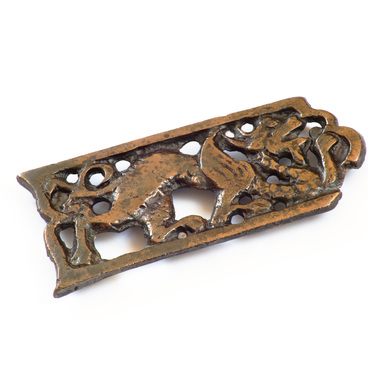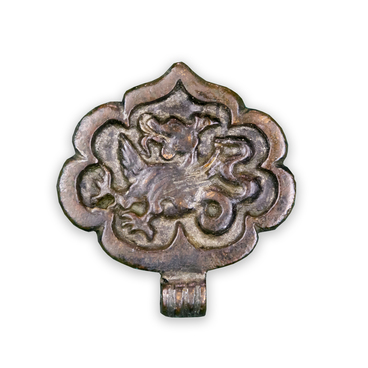The decoration from the collection of the Bolgar Museum-Reserve is a compound ornament, which consists of 2 plates, a pair of rounded rings, and also a pendant made in the form of a rosette with six petals and a round core. The exhibit is decorated with a weaving pattern with plant motifs.
The plate was attached to the belt and used to gird up clothes, which reached practically to the knees. Medieval warriors needed this belt, since weapons were hung on it.
Historians believe that for the first time a belt decorated with plates and a buckle appeared among the nomadic Turkic-speaking peoples shortly before the beginning of the Common Era. The quality of the belt and the material indicated the occupation, status in society and religious beliefs of the owner.
The plates for the ancient belt were made of different materials: gold, silver, or bronze. The leaders of the tribe and the priests possessed the most expensive ornaments. More modest belts were worn by military leaders. Ordinary representatives of the tribe had simple pieces.
In Volga Bulgaria, woven, leather, or knitted belts were made for men. In the 10th-13th centuries, they fulfilled a role of pockets, since clothes with pockets appeared several centuries later. Various small objects were attached to the belts: a tinderbox, a knife, bags for coins.
The men’s belt set consisted of several elements: a buckle with a frame and a prong, belt mordants, a clip to fix the end of the belt, and decorative plates. They were fastened with pins or studs. Archaeologists discovered a lot of bronze plates during excavations at the Bolgar and Starokuibyshev ancient settlements. The plates had rings for attaching various items. The most common pattern on these belt elements is a 6-petal rosette with a round core.
In Volga Bulgaria, the craft of metal processing flourished: craftsmen made not only jewelry and accessories for clothes from bronze and silver but also mirrors, interior items, weapons. Bulgarian products were appreciated both in the domestic and foreign markets: they could be found in the Middle and Upper Kama, as well as in many regions of Eastern Europe.
The plate was attached to the belt and used to gird up clothes, which reached practically to the knees. Medieval warriors needed this belt, since weapons were hung on it.
Historians believe that for the first time a belt decorated with plates and a buckle appeared among the nomadic Turkic-speaking peoples shortly before the beginning of the Common Era. The quality of the belt and the material indicated the occupation, status in society and religious beliefs of the owner.
The plates for the ancient belt were made of different materials: gold, silver, or bronze. The leaders of the tribe and the priests possessed the most expensive ornaments. More modest belts were worn by military leaders. Ordinary representatives of the tribe had simple pieces.
In Volga Bulgaria, woven, leather, or knitted belts were made for men. In the 10th-13th centuries, they fulfilled a role of pockets, since clothes with pockets appeared several centuries later. Various small objects were attached to the belts: a tinderbox, a knife, bags for coins.
The men’s belt set consisted of several elements: a buckle with a frame and a prong, belt mordants, a clip to fix the end of the belt, and decorative plates. They were fastened with pins or studs. Archaeologists discovered a lot of bronze plates during excavations at the Bolgar and Starokuibyshev ancient settlements. The plates had rings for attaching various items. The most common pattern on these belt elements is a 6-petal rosette with a round core.
In Volga Bulgaria, the craft of metal processing flourished: craftsmen made not only jewelry and accessories for clothes from bronze and silver but also mirrors, interior items, weapons. Bulgarian products were appreciated both in the domestic and foreign markets: they could be found in the Middle and Upper Kama, as well as in many regions of Eastern Europe.



